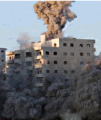Home > Rubriques > Languages - International > English > 200 Rescued in Iran After Quakes; Death Toll Rises to 300 By THOMAS (...)
Source : New York Times
200 Rescued in Iran After Quakes; Death Toll Rises to 300 By THOMAS ERDBRINK
Lundi 13 août 2012 - 13 h 24
Monday 13 August 2012
============================================
TEHRAN — Iranian relief workers saved more than 200 people from the rubble of dozens of villages destroyed when two powerful earthquakes struck Saturday in a wide area north of the city of Tabriz, an Iranian official said Sunday.
Mourners at a mass funeral Sunday in Varzaqan. The area was especially hard hit, with many mud brick houses collapsing, trapping residents.
The official, Hassan Ghadami, Iran’s deputy interior minister, said that “all those under debris have been rescued and those affected are now being provided with their basic needs,” the semiofficial Fars news agency reported. The head of Iran’s Relief and Emergency Organization said that rescue operations were continuing.
Reza Sedighi, a relief official in the area, told Fars that at least 300 people were killed Saturday, and other officials reported more than 4,500 injured, some severely. Doctors on the scene predicted that more people would be found under destroyed houses, mosques and farms. In total, 133 villages were damaged. Shortages of water and food are being reported throughout the quake zone, a mountainous region near the border with Azerbaijan.
The quakes struck in quick succession, with the more powerful one measuring a magnitude of 6.4, the United States Geological Survey reported. Iranian news media said that the epicenters were near four smaller cities north of Tabriz: Ahar, Heris, Mehraban and Varzaqan.
The villages near Varzaqan were hit especially hard, with many mud brick houses collapsing and trapping those inside, many of them women and children, the region’s governor, Moharram Foroughi, said.
“Most of the dead are women and children, as the earthquake happened during the day, when many men were out working,” said Marjan Lagaei, an Iranian reporter who traveled to the area.
Helicopters had to suspend rescue operations during the night as Iran — under international sanctions over its nuclear program — is barred from purchasing night-vision materials, which could be used for military purposes as well as civilian missions.
Iran’s interior minister, Mostafa Mohammad Najjar, visited parts of the disaster area by helicopter on Sunday morning, promising residents that their houses would soon be rebuilt. “All destroyed places will be rebuilt as strong as possible and all shortages existing in the region will be dealt with quickly,” he said, according to the official Islamic Republic News Agency.
In nearby Tabriz, the center of Iran’s Turkish-speaking Azeri region and one of Iran’s largest cities, tens of thousands spent the night on the streets, fearing further earthquakes. “Even old people here say they have never experienced such a powerful earthquake,” said Vahideh Porebadi, 40. Like all her neighbors, she spent the night sleeping in a city park. “I was lucky as I slept on a bench,” she said.
Iran lies on several major fault lines, and experts have said that the possibility exists that Tehran, a city of 12 million, could be hit by an earthquake of magnitude 7 or higher.
In 2003, a 6.6-magnitude earthquake struck the southern city of Bam, killing about 25,000 people.
One Iranian seismologist, Bahram Akasheh, said that Saturday’s temblor was relatively mild, and attributed the loss of life to shoddy construction and poor oversight. “Nowhere in the world would a magnitude 6 earthquake kill so many people. There shouldn’t have been more than 10 injured,” he told the semiofficial Iranian Labor News Agency on Sunday.
Mr. Akasheh, who has long predicted millions of deaths if an earthquake were to strike the capital, said Iran needed to prepare for even worse disasters in the future.
“Soon we will be hit by a 7 or higher quake,” he said. “I am very worried.”


